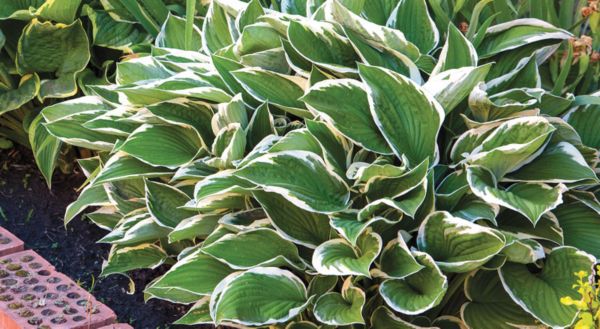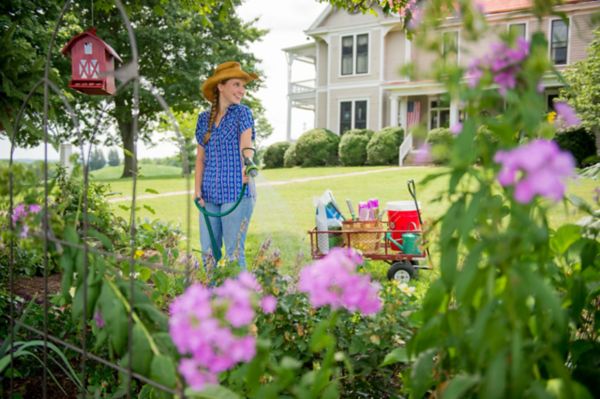How to Grow Daisies
Authored by Leah Chester-Davis
Daisies are known for their cheerful simplicity. A striking perennial, Shasta daisies are favorites in the garden, adding beauty to containers or at a farmgate. Their attractive flowers and rigid stems make them a popular choice to include in a cutting garden or a perennial garden. Few sites are lovelier than a large sweep of daisies. When established, this plant is typically drought tolerant. Daisies are usually resistant to deer. Bees and butterflies love them.
Daisies are readily recognizable with their many white petals that encircle a yellow or gold center, though the petals have varying hues, from white to cream to bright yellow shades, depending on the cultivar. The flowers are typically 2 to 5 inches wide, appearing during spring and summer. Both single and double-flowered cultivars are available. This garden staple pairs well and complements many colors or color combinations, reds, purples, oranges, pinks. Daisies seem to make greens more vibrant.
While Shasta daisies and ox-eye daisies are related and similar in appearance, the ox-eye daisy does not have the clump-like habit of Shastas. The downside to Ox-eye is that it is considered an invasive species in some states. Shasta looks like the common daisy, sometimes called English daisy, but grows in clumps or bushes.
About daisy
| Botanical name: | Leucanthemum x superbum (Shasta) |
| Common name: | Daisy |
| Plant type: | Perennial |
| Size: | 1 to 4 feet tall and 1 to 2 feet wide (plants); 2 to 5 inches wide (blooms) |
| Sun exposure: | Full sun |
| Soil type: | Sandy, Loam, Clay |
| Soil pH: | 5.5 to 7.5 |
| Hardiness zones: | 4 to 9, depending on cultivar |
| Average first frost: | Varies by region |
| Average last frost: | Varies by region |
| Container friendly: | Yes |
| Beginner friendly: | Yes |
Growing
Shasta daisies grow in average to fertile soil that is moist and well-drained with a pH from 5.5 to 7.5. If you are in an area with heavy soils, till it to a depth of 6 to 8 inches and work in 3 to 4 inches of organic matter. They prefer full sun, six or more hours per day. They can handle partial shade, and some afternoon shade can be beneficial. They can be grown from either seed or plants from your favorite garden center.
This plant can also grow in containers, adding a spot of sunny blooms to a patio, or the container can be moved to fill in spaces in the landscape. Use a good quality potting mix for ornamentals and place in a container with drainage holes.
While the common daisy and the Shasta daisy with the white petals and golden center are among the most traditional, there are many cultivars, including dwarf varieties that grow to about 8 to 12 inches, making them a good choice to grow at the front of garden beds.
In many regions, they are a hardy perennial but in warmer areas such as south and central Florida or southern Texas, high temperatures can kill it. In such climates, the Bush Daisy may be the better option.
What's a daisy?
Several plants may have “daisy” as part of their name. A few are:
Marguerite daisies (Argyranthemum frutescens), are less hardy and are often grown as an annual in zones 7 and cooler. They are quite showy in cooler temperatures of spring and fall. They are typically a perennial that grows in a mounded shrub form in zones 8 to 11. They are often found in garden centers growing in a standard or tree shape. They are beautiful in containers to accent patios or as a seasonal focal point in the garden. The blue Marguerite daisy is stunning with intense blue petals and bright yellow centers.
Gerbera daisies (Gerbera jamesonii) are available in a wide range of bright, cheery colors such as yellow, orange, white, pink, or red. They are typically grown as annuals in zones 7 or colder and need to be planted outside after the danger of frost has passed. In warmer climates, zones 8 to 11, they may grow as perennials. If grown in containers they can be brought indoors in the winter in colder climates. Place near a window so they can get adequate light.
Gloriosa daisies are a form of the black-eyed Susan (Rudbeckia hirta) with deep brown centers surrounded by yellow petals. They are beautiful paired with Shasta daisies in a perennial bed or cutting garden.
African daisies (Osteospermum spp.) have daisy-like flowers in a wide range of vibrant colors, extending well beyond the typical white and yellow. They grow to about 12 inches tall and will spread. African daisies are grown as an annual in all but the warmest zones, 9 and higher, so plant outdoors when the danger of frost has passed. They may suffer in hot and humid summer.
Bush daisies (Gamolepis chrysanthemoides) grow in a loose, rounded form. Like most daisies, they can grow in containers, mass plantings, or mixed flower borders. They become almost shrub like, growing up to 3 feet tall and 4 feet wide with lacy, fern-like foliage. They typically thrive in warmer climates.
Planting
The best time to plant this garden favorite is in the early spring or fall for potted plants. If seeding, plant when you can work the ground in the spring and into late spring. In more temperate climates the seed can be planted in the fall. Inquire at your local garden center or Extension office about best times for your area.
When preparing the planting area, work the soil and remove any competing weeds. A layer of compost mixed into the soil helps improve the soil tilth and drainage. When planting seeds, scatter them across the soil surface and gently tamp them down so they have good seed to soil contact. There is no need to cover them with soil as they need light to germinate. If planting small plants, dig a hole that is large enough for the plant. Set it into the hole, planting at the same depth it grew in its container. Fill the hole with the soil. If the plant is in a peat container, make sure the edges of the container are covered with soil to prevent it from wicking moisture away from the plant. Tamp down the soil around the top of the crown, with the crown just above the soil. When planting several plants, space 8 to 12 inches apart. Water the plants thoroughly after planting and keep them watered throughout the growing season. Container plants may need water more often. Add organic mulch to help suppress weeds.
After the blooms have faded or died back, deadhead them by cutting the stems just below the foliage. This helps the plant put more energy into producing another flush of blooms. Deadhead regularly to keep the plant blooming.
Established daisies can benefit by dividing them. You get more plants, and the plants get a chance to rejuvenate, particularly if they have become woody in the center. This may need to be done about three years after you have planted them.
Fertilizing
If the soil is fertile, there is no need to fertilize at the time of planting. Soil with organic compost added will likely need less fertilizer than poor soil. Garden beds of established plants will benefit from an application of compost annually, which reduces fertilizer needs.
Keep an eye on your plants and about a week before they bloom, work a balanced fertilizer into the soil. Container plants may benefit from a couple of light applications during the season of a liquid fertilizer high in phosphorus. Follow label directions.
Controlling Pests, Diseases, and Other Problems
Daisies typically do not have problems with insects and diseases. Aphids can appear in early spring but likely will not be cause for concern or action.
Daisies typically stay insect and disease-free.
Harvesting
Daisies bloom from July to September. They are a lovely cut flower. Cut during the cool part of the day for an arrangement of just daisies or mix with other perennials.
Storing
Daisies will last several days in an arrangement. Change out the water every day or so to get rid of any bacteria in the vase.
Expert Tips
- ‘Sweet Daisy Birdy’ is a 2021 All-America Selections (AAS) Perennial Winner. It is noted for its long-lasting blooms in gardens to zone 3. It is cold and heat tolerant. The showy blooms are up to 5 inches across with long white petals, and popular for moon gardens. There is not a lot of maintenance; even deadheading is optional.
- ‘Carpet Angel’ is the first-ever groundcover Shasta Daisy to win an AAS Award and is a 2023 winner. It has 3-inch flowers, grows to only about 6 inches tall, and spreads up to 20 inches wide. Hardy in zones 4a to 10b. AAS winners are tested by horticulture professionals across North America.
- ‘Becky’ has long been a favorite; the Perennial Plant Association named it Perennial of the Year in 2003.
Frequently asked questions
May I put Shasta daisies in a container and bring inside?
Shasta daisies are outdoor plants and, in most climates, will overwinter outdoors. They will not be happy inside. If you are looking for the cheery, daisy-like blooms for indoors, try gerbera daisies.
What are some plants to include with daisies in a perennial garden?
The possibilities are endless! Daisies are quite lovely with a wide range of colors so go with your favorite or plant a mix. Start by planting several plants of the same kind grouped together. So, rather than just one daisy, plant at least three to five. Some perennial possibilities are coneflower, Black-eyed Susan, salvia, sedum, amsonia, monarda, yarrow, phlox, Russian sage, veronica, and coreopsis.
Is it necessary to deadhead daisies?
Deadheading can help encourage the plant to keep producing blooms. If you have a container or two of daisies, it is much easier to keep them deadheaded than a large mass planting. If you simply cannot get to this chore, do not worry about it. The plant may not bloom more than once during the season but that does not mean it will not bloom the next growing season. Some of the newer varieties, such as the AAS Winner Sweet Daisy Birdy, does not have to be deadheaded.





